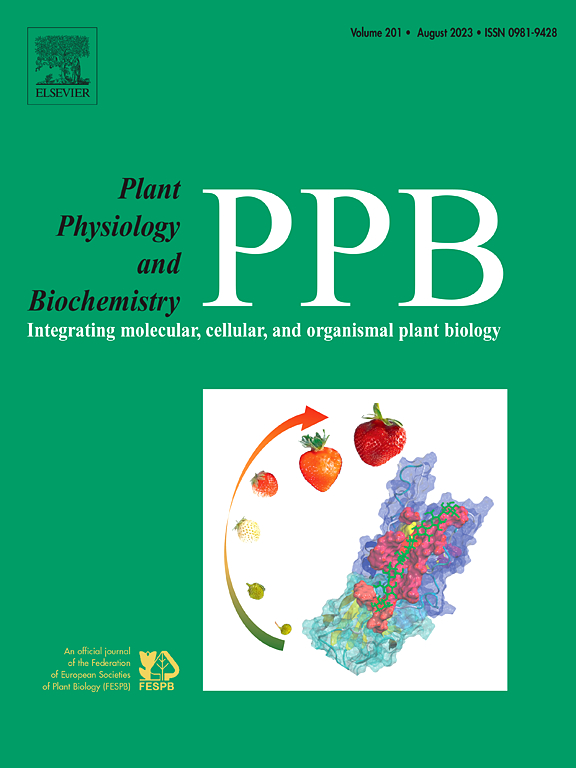激发子介导的薰衣草悬浮培养中迷迭香酸生物合成及细胞提取物体外生物活性的研究
IF 6.1
2区 生物学
Q1 PLANT SCIENCES
引用次数: 0
摘要
薰衣草因其生物活性和必需化合物而被广泛报道。然而,证实金针叶细胞悬浮培养提取物生理活性的研究有限。在本研究中,开发了一种利用诱导技术的高产方法,专门用于提高L. angustifolia细胞悬浮培养中迷迭香酸(RA)的产量。在所测试的各种激发子中,茉莉酸甲酯(MJ)处理对RA的产生最有效。在100 μM MJ处理3天的细胞悬浮培养中,RA产量最高,为16.4 mg/g干重(DW)。MJ的应用激活了RA生物合成途径相关的结构基因(PAL、C4H、4CL、TAT、HPPR、AAT1、CYP450)的表达,从而显著提高RA的产生。此外,在1吨生物反应器中培养的经mj处理的细胞提取物显示出明显的高抗氧化活性,抑制黑色素合成,增强前胶原合成。这些发现不仅证明了mj处理的鹅口角细胞大规模培养的可行性,而且突出了其在化妆品和制药方面的工业应用潜力。本文章由计算机程序翻译,如有差异,请以英文原文为准。

Elicitor-mediated enhancement of rosmarinic acid biosynthesis in cell suspension cultures of Lavandula angustifolia and in vitro biological activities of cell extracts
Lavandula angustifolia is widely reported for its biological activities and essential compounds. However, research confirming the physiological activities of L. angustifolia cell suspension culture extracts is limited. In this study, a high-yield method utilizing elicitation techniques was developed, specifically aimed at enhancing the production of rosmarinic acid (RA) in L. angustifolia cell suspension cultures. Among the various elicitors tested, methyl jasmonate (MJ) treatment was the most effective in enhancing RA production. The highest RA production [16.4 mg/g dry weight (DW)] was observed in cell suspension cultures treated with 100 μM MJ for 3 days. MJ application activated the expression of structural genes (PAL, C4H, 4CL, TAT, HPPR, AAT1, and CYP450) involved in the RA biosynthetic pathway, thereby significantly enhancing RA production. Furthermore, extracts from MJ-treated cell cultures grown in a 1-ton bioreactor exhibited significantly high antioxidant activity, inhibition of melanin synthesis, and enhanced procollagen synthesis. These findings not only demonstrate the feasibility of large-scale cultures of MJ-treated L. angustifolia cells but also highlight their industrial potential for applications in cosmetics and pharmaceuticals.
求助全文
通过发布文献求助,成功后即可免费获取论文全文。
去求助
来源期刊
CiteScore
11.10
自引率
3.10%
发文量
410
审稿时长
33 days
期刊介绍:
Plant Physiology and Biochemistry publishes original theoretical, experimental and technical contributions in the various fields of plant physiology (biochemistry, physiology, structure, genetics, plant-microbe interactions, etc.) at diverse levels of integration (molecular, subcellular, cellular, organ, whole plant, environmental). Opinions expressed in the journal are the sole responsibility of the authors and publication does not imply the editors'' agreement.
Manuscripts describing molecular-genetic and/or gene expression data that are not integrated with biochemical analysis and/or actual measurements of plant physiological processes are not suitable for PPB. Also "Omics" studies (transcriptomics, proteomics, metabolomics, etc.) reporting descriptive analysis without an element of functional validation assays, will not be considered. Similarly, applied agronomic or phytochemical studies that generate no new, fundamental insights in plant physiological and/or biochemical processes are not suitable for publication in PPB.
Plant Physiology and Biochemistry publishes several types of articles: Reviews, Papers and Short Papers. Articles for Reviews are either invited by the editor or proposed by the authors for the editor''s prior agreement. Reviews should not exceed 40 typewritten pages and Short Papers no more than approximately 8 typewritten pages. The fundamental character of Plant Physiology and Biochemistry remains that of a journal for original results.

 求助内容:
求助内容: 应助结果提醒方式:
应助结果提醒方式:


